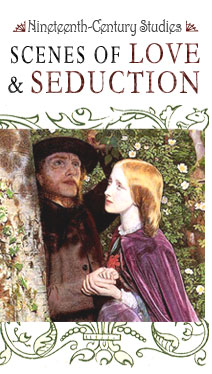Jeffrey Weeks , Sex, Politics and Society: The Regulation of Sexuality Since 1800.from Chapter 2, "'That Damned Morality': Sex in Victorian Ideology" (1981)
Transcribed from pages 19-20, 22, 24-25, 30 and 32-33 of Sex, Politics and Society: The Regulation of Sexuality Since 1800. Published by Longman, 1981.
1.
"From the end of the eighteenth century with the debate on over-population and the hyperbreeding of the poor, sexuality pervades the social consciousness: from the widespread discussions of the birthrate, deathrate, life expectancy and fertility in the statistical forays of the century to the urgent controversies over public health, housing, birth control and prostitution. . . .The reports of the great Parliamentary Commissions, which in the 1830s and 1840s investigated working conditions in factories and mines, were saturated with an obsessive concern with the sexuality of the working class, the social other, displacing in the end the acute social crisis from the area of exploitation and class conflict, where it could not be coped with, into the framework of a more amenable and discussable area of 'morality'. From the 1850s sexuality, particularly in the wide area of venereal disease and prostitution (allied to feats that Britain would follow Rome into imperial decline) enters the heart of Parliamentary debate. The controversy over the Contagious Diseases Acts, passed in the 1860s to impose compulsory medical examination and registration on working-class women suspected of being prostitutes in designated garrison and naval towns, generated an avalanche of controversy and publications. The Acts were the subject of repeated Parliamentary enquiries, while the repeal organizations alone published at least 520 books and pamphlets on venereal disease and prostitution. Between 1870 and 1885, 17,367 petitions against the Acts, with 2,606,429 signatures were presented to the House of Commons, and over 900 public meetings were held by supporters of repeal.
Other legislative changes produced their own effects. The divorce act of 1857 evinced a flurry of interest in the next decade in stories of bigamy and adultery: a special paper, The Divorce News and Police Reporter, was founded to cater for specialized tastes, but other Victorian papers, like their more familiar twentieth-century offspring, were full of divorce cases and other sexual scandals" (19-20).
"The popular morality of the vast majority was no less strict for being loosely Christian in a formal sense. As G.R. Quaife has put it, 'God does not loom large as a damper on lower-class sexual activity.' This should not be taken to imply that there was in any sense an unrestrained licence for peasant sexuality; there was no 'amorality' in a fundamental sense. There was, on the contrary, an often strict morality, enforced through various informal and traditional methods such as those of public shaming, the charivari and skimmington rides. But it was a social morality, in which the potential economic burden to the community of bastards mattered more than the 'immorality' of premarital sex.'
What seems to be happening in the nineteenth century, in response to major social changes (rapid industrialization and urbanization, the disruption of old class patterns and the rise of capitalist social relations, the development of new and sharp class conflicts with their related social and intellectual manifestations) is a continuous battle over the definition of acceptable sexual behaviour within the context of changing class and power relations. And there are different rhythms in this process. There was no blanket imposition of 'repression.' Not until the 1880s did 'social purity' have any major legislative purchase; and it is significant that it is from this period that the earliest critiques of 'Victorianism' stem" (22-23).
"The new marriage laws (especially those after 1836, which granted the right to marry to nonconformist chapels as well as civil registrars) had the effect of making the betrothal less binding and of sharply differentiating the married from the unmarried, hence making the difference between licit and illicit sex more important. Earlier traditions survived in rural areas and amongst the unorganized and disrupted working class, but marriage became increasingly the gateway to respectability and stability. It was buttressed by an increasing idealization of domesticity, a growing specification and rationalization in the censure of extra-marital sex (partly articulated by what one sex reformer called 'the continued extension of criminal law') and by the difficulty of divorce. The 1857 Matrimonial Causes Act, which set up secular courts and procedures, established no new principle not involved in the old form of divorces by petitions in Acts of Parliament. The only principle abandoned in 1857 was the propriety of making legal remedies for marriage difficulties available for the aristocracy while withholding them from the growing upper middle class. Change was slow: divorce rose from an annual average of 148 in the decade after 1851 to 582 in the decade before 1900; and divorce remained a strong social stigma. Even innocent parties were excluded from court until 1887. In the working class, though the stigma might be less, the difficulties were even greater and divorce was quite out of the question for most" (24-25).
"The life style of the bourgeois lady was purchased at the expense of a large class of servants, often prone to sexual depredations, and an equally vulnerable group of prostitutes. The ideological division of women into two classes, the virtuous and the fallen, was already well developed by the mid-eighteenth century: its reality was to have a vivid impact on the Victorian imagination. Nor did it go unchallenged. The evangelical and puritan strands vigorously opposed the double standard, and by the last decades of the century were able to pose a significant challenge to its easy acceptance. Nonetheless, it is inescapably true that familial ideology was accompanied by, and often relied on, a vast underbelly of prostitution, which fed on the double standard and an authoritarian moral code" (30)
"Sexuality thus had an extremely complex and vital symbolic role in what became the dominant ideology in the nineteenth century. First and foremost, sexual respectability expressed the aspirations and lives of the middle class. Only secondarily was it for export to other classes. It is here that theorizations which see the nuclear family as a means for controlling the working class in the 'interests of capitalism' can be seen to be inadequate. . . .
[D]espite . . . earnest evangelical endeavors it is probably true to say that many bourgeois groups had little direct interest in working-class morality, as long as work relationships were secured. In the debate over the great Commissions of Inquiry of the 1830s and the 1840s, divisions amongst the bourgeoisie were quite clear. Neither the interpretations nor the prognostications of men such as Lord Ashley were universally acceptable and the 'colonizing' efforts were largely unsuccessful. By the 1890s the seats of sexual respectablity were seen by reformers such as Grant Allen to rest in the lower middle class and the upper working class, but in the latter there was no simple acceptance of middle-class norms. What was taking place was much more complex, and the working-class patterns of family and sexual life that were brought to the twentieth century were as much the product of working-class adaptation to rapid change in the context of a ruling set of ideas as a successful colonization. nevertheless, the existence of this vast and strange symbolic other served to confirm the rightness, indeed righteousness, of the moral code. It is in this context that we can appreciate the truth of Foucault's dictum that 'sexuality' was originally and fundamentally bourgeois in origins. It was in the great middle classes that sexuality, albeit in a morally and sharply defined form, first became of major ideological significance" (32-33).








